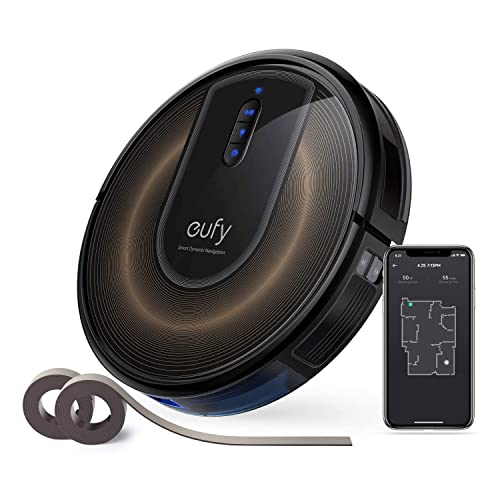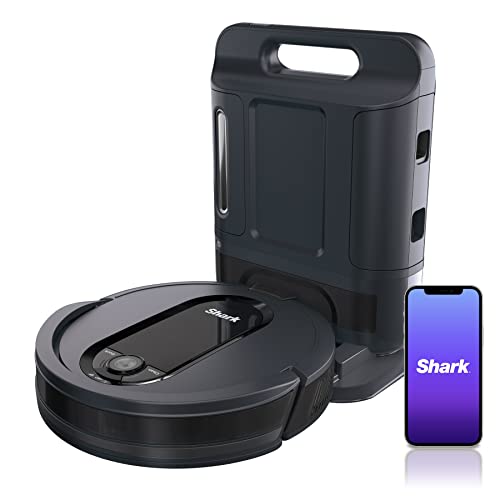A self-emptying robot vacuum is one of the most useful things you can purchase for your home. It makes the cleaning process hands-off and more efficient, particularly for people with larger homes.
The dock of a robot sits on a tiny bin that can be emptied frequently, as often as every couple of days or more often, depending on the model. Self-emptying bases are typically larger and can be heavy.
It's more practical
If you're tired of emptying the robot's dust bin after each cleaning session, consider splurging on a self-emptying model. These bases contain dirt in a much larger container, and are usually rated for how many days (or cleaning sessions) they can last before you need to dump them. This means that your robot is less likely to release dust clumps to the air and make allergies worse.
These models are typically more advanced than traditional robot vacuums, making them more user-friendly. Some models come with a map that allows you to label rooms or create virtual no-go zones within specific areas. Others can return to their base automatically to recharge after they have completed cleaning or when power runs out. Some models have multiple cleaning modes such as spot-clean, mop and auto-mop. Others offer voice control through Alexa or Google Assistant.
But be prepared for a noisy process. If the bin is full, the device will usually take a minute to empty it, which could cause disruption. You can change the settings so it's quieter, but it will still be louder than other types of vacuums. Some models have DND modes also, which can be helpful when you need to use the device in a bedroom, or any other location where it might disturb you.
Robotic vacs may also get stuck in furniture or door thresholds, get tangled in things like cords, shoelaces or pet toys or even simply lose their direction and send an SOS signal to you asking for help. You'll need to physically place the robot vacuum back into its base to reorient it and resume its cleaning session or charging session. It's not the most pleasant experience however, but you'd need to do this manually with any other vacuum.
Overall, self-emptying robot vacuums provide a lot of convenience and are well worth the cost in case you're bored of emptying the robot's trash bin after every cleaning cycle. It is important to keep in mind that these vacuums are not suitable for all homes. Their dirt capacity is smaller than a standard vacuum and their base may not be big enough for some households.
It's safer
While a robot vacuum is more advanced than your traditional barrel or stick vacuum, it is still a machine with moving parts that can be destroyed as easily. This makes it more expensive and difficult to fix than a standard vacuum. In addition, many robot vacuums require more frequent maintenance, like cleaning the brushes and filters, as opposed to regular vacuums. Some robot vacuums have extra components, like sensors, a computer brain, cheap and best robot vacuum cleaner and mop apps integration. This makes them more difficult to maintain and use.
The good news is that a lot of these issues can be avoided with a self emptying robot vacuum. Manufacturers rate products by the amount of dirt that can be stored in the external container for 30-to-60 days. It is easy to fill up the canister of your robot vacuum if you have to empty it every two weeks. If your robot can automatically empty the canister and then empty it, not only will it be more user-friendly it, but you'll be able to run it more often.
 Many manufacturers also sell additional filters and brush kits which can be used to replace worn out ones. This will allow your robot last longer and perform at its peak. It's a better investment than a basic model. Some brands also offer zoned saving features, which allow you to establish zones of no-go areas to ensure that your robot does not accidently clean certain areas.
Many manufacturers also sell additional filters and brush kits which can be used to replace worn out ones. This will allow your robot last longer and perform at its peak. It's a better investment than a basic model. Some brands also offer zoned saving features, which allow you to establish zones of no-go areas to ensure that your robot does not accidently clean certain areas.In addition, a majority models also have a quiet mode, which will make it less likely to distract you while the machine is running. This is particularly useful when you have pets or have small children. If you have a smart house or work from home, you can schedule the robot to come when you are not home.
It's cheaper
A robot vacuum can only hold a limited amount of dirt before needing to be cleaned. When that occurs, the dust gets returned to the air, which can cause sneezing in families who suffer from allergies. This issue can be eliminated with self-emptying robot vacuums. They automatically empty the dust into a bin outside. The most reliable models can last for months or even years without having to empty the bin.
These robots are perfect for busy households as they aid in keeping your home tidy without needing to stop in the middle of something else to empty the base. They're especially helpful in high-mess areas such as kitchens or living rooms where children and pets are likely to leave their mark. These are also a great investment for older homes with a hard time keeping clean.
As more robotic vacuums with self-emptying bases are introduced to the market, their price is dropping. The majority cost $400 or less. That's a big saving over the Around $1,400 on a typical robot vacuum. These vacuums also have more versatility than traditional models. Some are able to work in dry and wet mode, allowing you to use them for wet and sticky spills as well as soiled carpets.
They also can work with apps to schedule cleaning sessions and connect to digital voice assistants like Alexa, Google Assistant or Amazon's Echo. This makes them easy to use for those who don't have the time or patience to operate a robot vac with the remote.
There are some disadvantages with this technology, however. The bases are large and take up more floor space. They are also heavy, which adds to the total cost of the device. Additionally, the process of emptying can be noisy and slow.
You'll still have to clean other areas of your home frequently, even though self-emptying robot vacuums can save you time and effort. You should also remove any wet spills, and wipe down the sensors and charging contacts on the robot's dock as well as base.
It's also more eco-friendly.
The most effective self-emptying robot vacuums are usually more environmentally friendly than their non-self-emptying counterparts. The docking station of the vacuum functions as a bin to collect the debris left from cleaning cycles. The dustbin can be empty and replaced with a new one, just as a regular vacuum. The filtered bin also helps trap fine dust particles that could otherwise be released into the air of your home, making these robots an ideal choice for homes with allergies or respiratory conditions.
However, despite their improved environmental friendliness, some self-emptying robots have drawbacks. They can be noisy, for example. The noise can be louder than a vacuum motor, and occur at random times during a cycle. This can be distracting, especially if you are doing work or cooking while the machine is running.
Self-emptying robots are also problematic because they take up a lot of space on your floor. They usually have a huge base that can hold months or weeks of garbage. This can be a problem in small homes or apartments where every square inch counts. If you choose a model which can also mop, the water tank is huge and will require a larger area to stop it from overflowing or spilling out.
Self-emptying robots are also more difficult to set up. You'll also need to choose an area for the base which is not too obstructive. The sensors and charging contacts also require cleaning before they can be used. In addition, most of these models require an initial, non-cleaning run to draw the map of your home. Different brands use different mapping techniques, including smart cameras and LIDAR (Light Detection and Ranging) which functions similarly to radar.
In the end, a robot vacuum that can self-clean itself is an excellent investment. It will make your life easier. If you're a busy parent who has to manage children as well as work and other chores, it'll be especially helpful to be able to turn the robot off and let it go to its own devices.

 Room
Room
 My Channels
My Channels 

